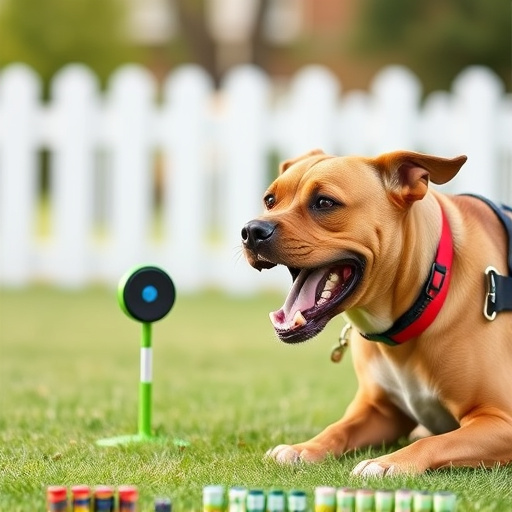Dog repeller devices, powered by efficient low-power components and smart power management systems, offer a sustainable solution for property protection against unwanted dogs. These modern models prioritize energy conservation through advanced sensors, extending operational life and reducing environmental impact. When reviewing these devices, focusing on power source and energy usage ensures reliability and aligns with eco-conscious preferences. However, performance inconsistencies in larger areas or around obstacles, and potential limitations against persistent dogs, highlight the need for complementary security measures.
Personal security dog deterrents have gained popularity as a non-lethal way to protect spaces. This article delves into the world of dog repeller devices, exploring their functionality, energy efficiency, and overall effectiveness. From understanding how these tools use sound or ultrasonic waves to deter dogs to analyzing their power consumption, we provide a comprehensive review covering features, advantages, and potential drawbacks. By examining real-world performance, this guide aims to equip readers with the knowledge to make informed decisions about dog repeller devices.
- Understanding Dog Repeller Devices: How They Work
- Power Consumption Analysis: Energy Efficiency in Action
- Evaluating Effectiveness: Are These Devices Really Effective?
- A Comprehensive Review: Features, Pros, and Cons
Understanding Dog Repeller Devices: How They Work
Dog repeller devices are designed to protect your property by deterring unwanted dogs from entering, using a range of technologies to achieve this. These devices typically emit sounds, ultrasonic waves, or spray a mild irritant to create an unpleasant experience for the intruding canine. The primary principle behind their functionality is to trigger a dog’s natural aversion to certain stimuli, teaching them to associate your property with discomfort and stay away.
At the heart of these devices’ effectiveness lies their power consumption. A crucial factor in choosing a suitable dog repeller is understanding its energy requirements. Modern models often boast low power consumption, making them highly efficient and environmentally friendly. When reviewing dog repeller devices, considering their power source and energy usage can help you select a reliable, long-lasting solution that aligns with your lifestyle and eco-conscious preferences.
Power Consumption Analysis: Energy Efficiency in Action
Personal security dog deterrent devices, often powered by batteries, have evolved to become more energy-efficient, a trend driven largely by consumer demand for longer operational durations between charges or battery replacements. A power consumption analysis of these devices reveals a significant shift towards low-power components and smart power management systems. These innovations allow the dog repeller device to maintain optimal performance while minimizing energy use.
In the past, higher power consumption was often justified by the need for stronger signals and continuous operation. However, modern devices prioritize energy efficiency, integrating advanced sensors that detect presence and adjust output levels accordingly. This ensures that when an intruder is detected, the device responds with minimal energy expenditure, significantly extending its operational life between recharges. A Dog Repeller Device Power Consumption Review highlights this aspect, emphasizing how thoughtful design and engineering contribute to a more sustainable and cost-effective user experience.
Evaluating Effectiveness: Are These Devices Really Effective?
The effectiveness of personal security dog deterrent devices is a topic of interest for many, especially with the growing popularity of such products. These devices often claim to repel dogs through various means, from ultrasonic sounds to spray-based deterrents. However, when it comes to evaluating their true efficacy, it’s essential to consider several factors. One key aspect is power consumption; these devices may require frequent charging or battery replacement, which could impact their overall usability and sustainability.
A thorough review should also assess the range and consistency of the deterrent signal. Do they work as claimed over different distances and in various environmental conditions? Additionally, understanding user experiences and independent tests can provide valuable insights. Some devices might be effective in controlled settings but less so in real-world scenarios due to power limitations or unpredictable dog behavior. Thus, a critical analysis is necessary to discern if these dog repeller devices live up to their promises, particularly when considering the energy source and its impact on performance.
A Comprehensive Review: Features, Pros, and Cons
Personal security dog deterrent devices, also known as dog repeller devices, have gained popularity for their promise to protect individuals and properties from unwanted canine intruders. When reviewing these products, a comprehensive assessment is crucial to understanding their capabilities, limitations, and overall effectiveness. This review delves into essential features, examining both the advantages and disadvantages of these innovative solutions to dog-related security issues.
In terms of power consumption, dog repeller devices often rely on rechargeable batteries, which is an eco-friendly approach that also ensures continuous operation without frequent replacement costs. The pros include their portability, making them ideal for outdoor spaces like patios or gardens, and adjustable settings that cater to different scenarios and distances. However, some users report inconsistent performance, with signals weakening in larger areas or when surrounded by tall obstacles. Additionally, while these devices offer a non-lethal approach to deterring dogs, they may not be as effective against persistent or aggressive canines, highlighting the need for complementary security measures.
Personal security dog deterrent devices have emerged as a solution for managing canine intrusions, offering both convenience and potential effectiveness. Through understanding their operation, analyzing power consumption for energy efficiency, and evaluating their overall efficacy, we find these devices present a viable option for certain scenarios. A thorough review reveals a mix of benefits and drawbacks, emphasizing the importance of choosing the right dog repeller device to suit individual needs. By considering factors like power consumption, this guide enables users to make informed decisions, ensuring an effective and efficient solution to dog-related security concerns.
